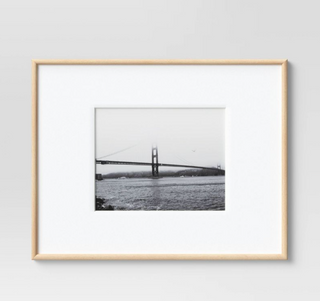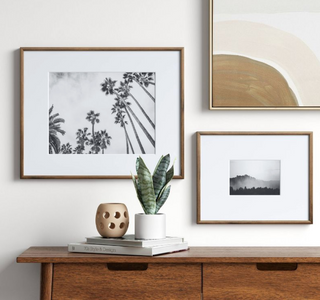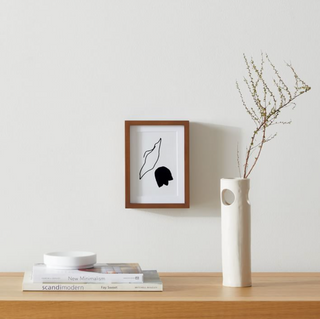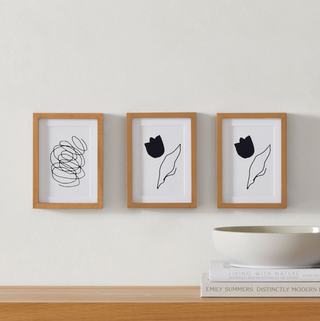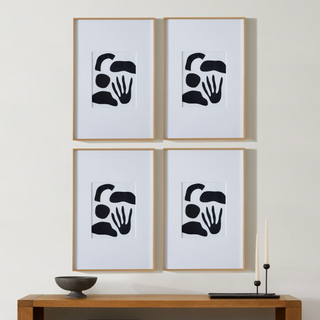Choosing a frame for your art is crucial. The right frame not only enhances your art, but also complements your interior design style and reflects your personality. However, the process of finding the perfect frame can be quite daunting with all of the options available.
Whether you're looking to frame a valuable piece of fine art, a beloved family photograph, or an art print curated by us, understanding the pros and cons of different framing options can make this task less intimidating.
Let's explore the four main categories of frame sources: affordable retailers like Target, mid-tier providers such as West Elm, custom framing options such as Michael's or local frame shops, and the ever-resourceful secondhand market. We'll delve into the advantages and disadvantages of each, helping you make an informed decision for your framing needs.

Affordable
(Target, IKEA, H&M Home, etc. )
Pros
- Cost: These frames are typically the least expensive option, making them ideal for those on a tight budget.
- Availability: Can be purchased quickly and conveniently, both in-store and online.
- Variety: There's often a wide range of styles and sizes to choose from, which can be great for standard size prints or photos.
Cons
- Quality: The materials used may not be as durable or well-made as more expensive frames.
- Size Limitations: May not accommodate unusual or very large artwork sizes.
- Customization: Limited customization options compared to mid-tier or custom frames. Ex: some mats that come with affordable frames may not be removable, so make sure you check before buying.
Image Via Target
5 x 7 Print
8 x 10 Print
11 x 14 Print
12 x 12 Print
*We recommend the mid-tone natural and walnut finishes

Mid-Tier
(West Elm, Crate & Barrel, Pottery Barn, etc.)
Pros
- Quality: These frames are often made with better materials than more affordable frames and may be more durable.
- Design: Often offer more stylish or unique designs that can complement your home decor.
- Some Customization: May offer more sizes and styles than the more affordable frames. Ex: West Elm mats are interchangeable to display different sized art in the same frame.
Cons
- Limited Customization: While there may be more options than the more affordable frames, the customization is still not as extensive as custom framing.
- Availability: May not be as readily available or easy to purchase on short notice.
Image Via West Elm
We recommend the walnut wood, wheat wood, and white wood finishes
5 x 7 Print
- 5 x 7 frame without mat
- 8 x 10 frame with mat
- 12 x 12 frame with mat
- 12 x 16 frame with mat
- 18 x 18 frame with mat
8 x 10 Print
11 x 14 Print
12 x 12 Print
*We recommend the walnut wood, wheat wood, and white wood finishes

Custom
(Michael's, Hobby Lobby, Local Framing Shops, etc.)
Pros
- Customization: You can get a frame that fits your artwork perfectly, both in terms of size and style.
- Quality: These frames are typically the highest quality, using premium materials and craftsmanship.
- Preservation: Custom frame shops often use archival-quality materials that can help protect your artwork over time.
- Michael's is always running sales!
Cons
- Cost: Custom framing is generally the most expensive option.
- Time: Custom frames take time to make, so this is not the best option if you're in a hurry.
- Accessibility: Requires more effort and planning than picking up a frame at a store.
Image Via W Magazine

Secondhand
(Flea markets, antique stores, estate sales, etc.)
Pros
- Cost: Buying secondhand is typically cheaper than buying new, and you can often find high-quality frames at a fraction of the original cost.
- Unique Finds: Secondhand shops, flea markets, and estate sales often have unique, vintage, or hard-to-find frames that can add character to your artwork.
- Sustainability: Buying secondhand is a more sustainable option, as it promotes reuse and reduces waste.
- Customizable: While the frame itself might not be custom, you can easily customize the look with a custom mat. Many places, including Michael's, can cut a mat to fit any frame size. This allows you to adapt a secondhand frame to fit different pieces of artwork.
Cons
- Time and Effort: It can take time and effort to find the right frame when shopping secondhand. The selection is unpredictable and can vary greatly.
- Condition: Secondhand frames may have signs of wear and tear or might need some refurbishment.
- Size Limitations: You're restricted to the sizes that are available secondhand, and it may be challenging to find the exact size you need.
- No Returns: Most secondhand purchases are final sale, so you need to be sure about your purchase.
Image Via Apartment Therapy
Keep in mind that the right choice depends on your specific needs, budget, and the artwork you're framing. If it's a valuable or sentimental piece, it may be worth investing in custom framing to preserve it properly. On the other hand, for decorative pieces or if you're changing your decor frequently, a more affordable option might make sense.
xx
Abigail



